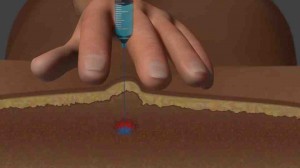What is a Trigger Point?
These are portions of painful muscles that are sore and feel like tight bands or knots when pressed. Pushing on one of these points will “trigger” pain at the pressure area and frequently in other areas. For  instance, pushing on a trigger point on top of the shoulder might send pain down the arm or up in the neck.
instance, pushing on a trigger point on top of the shoulder might send pain down the arm or up in the neck.
Trigger points are areas of muscles that are overactive that can be caused by stress, muscle over use, or problems with posture or the spine. They are often treated by better posture, reduced stress, and exercise. Occasionally, these treatments won’t stop a trigger point pain, and your AZ Work Comp Doctor may prefer to further treat the area with a trigger point injection.
How Are These Points Injected?
When doing this injection, your Phoenix workmans compensation pain doctor will spot the skin over this point, clean the area, and then introduce a very fine needle through the skin right into the area of the trigger point, causing a “twitch”. You might be able to feel this twitch. It tells the physician that the trigger point has been touched.
Physicians will then inject a small amount of medication numbing the trigger area, and you might feel burning at this time. This step is not essential for the trigger point treatment, but will make you feel better during the remainder of the treatment. The action of the needle is actually what makes the trigger point relax.
Once the numbing medication is injected, your work comp doctor in AZ will move the needle gently out and in the area of the trigger point, many times changing direction to ensure it is all treated. If you feel a lot of pain or if a twitch happens again, the physician might numb the area before proceeding.
Most treatments for these trigger point take 1-2 minutes. When complete, a tiny amount of pressure will be applied to half any bleeding, and a bandage or other dressing might be applied. Your physician might also spray the skin with a cooling spray to lessen any pain on the top of the skin. He may ask you to stretch the treated muscle.
Are There Risks?
The risks of treatment depend a lot on what area of the body will be treated. The risk is very small – about the same as for any injection. Some patients have had bleeding or infection. Some patients are allergic to the medication used.
The physician should be told of any allergies prior to any treatment taking place. For some injections, puncture of the lung or other organs with the needle can occur, but is very rare.
What to Expect Afterward?
You usually feel relief instantly following the trigger point injection, since the medication will numb any pain from the shot. Usually the relief will last 4-10 hours or until the medication wears off. You might then feel some  tenderness, like you might feel after a flu shot. You may stretch the muscle, use cold packs or ice, or take pain medication to care for this soreness.
tenderness, like you might feel after a flu shot. You may stretch the muscle, use cold packs or ice, or take pain medication to care for this soreness.
Within 1-2 days, the soreness should grow fainter, but the trigger point relief should last. There should be less pain than before the treatment. While these treatments do not always work, most patients get relief for days, weeks, or sometimes months.
These treatments may be done every few weeks to months, if needed, but scars may form if treatment is done too often.
What to do After the Injection?
When you are pain free, use the time to stretch the muscle, perform your exercise program, and take any other steps that will keep the trigger point from coming back.
Injecting Other Medication?
Some doctors use other medications, such as steroids, as trigger point treatment. None of these medications has been shown to work any better than simply a needle alone or with local numbing medication. Botulin toxin has been tried for use in trigger point treatment to make the  relief last longer. While this seems to be safe, it is not clear how well this drug works on trigger points.
relief last longer. While this seems to be safe, it is not clear how well this drug works on trigger points.






Leave A Comment